
This orange pavlova is sure to be your new favorite winter dessert
When I think of wintry desserts, the first flavors that come to mind are warm spices and rich, gooey melted chocolate. But my favorite dessert of the moment is much lighter: a pavlova featuring seasonal oranges and tangy cream atop a cloud of delicate baked meringue.
A great pavlova is crisp on the outside with a soft and marshmallowy center. While made from the same stuff, an ethereally delicate pavlova bears little resemblance to one of those crunchy, sweet, and chalky meringue cookies you can buy from the grocery store. It’s also one of the best gluten-free desserts you can make.
Like all iterations of meringue, a pavlova begins by whipping egg whites with sugar. You want to whip the mixture for at least five minutes to ensure that all the sugar granules are fully dissolved. You can test for this by rubbing a small amount of meringue between your fingers—it should feel totally smooth and not grainy in the slightest. Don’t worry about overmixing. The large proportion of sugar stabilizes the mixture, meaning that it’s near impossible to overmix a meringue with a high proportion of sugar (whereas it’s actually pretty easy to overwhip egg whites that haven’t been mixed with sugar). Once fully whipped, the meringue is formed into four petite “nests” that will be the perfect shape for filling with fruit and cream once baked.

When it comes to a pavlova, the meringue should bake low and slow. If cooked too fast, the meringue will lose its clean white color and turn a muddy pinkish-beige. You’re looking at a long bake time—90 minutes—but it’s worth it for that cloudlike texture. Instead of immediately taking the meringue out of the oven to cool, keep it inside with the door cracked, as a dramatic temperature shift will result in collapsing or cracking. If this does happen, however, it’s nothing that a pile of delicious toppings can’t cover up.
Since the meringues are already packed with sugar, it’s best to use a light touch when it comes to sweetening any toppings. Heavy cream whipped with a spoonful of yogurt brings a pleasant, mild tanginess. I don’t add any sugar here, instead opting for a bit of orange zest to lend its citrusy perfume. Oranges can vary in sweetness, but I like to drizzle mine with just a bit of honey, which helps them to macerate slightly and creates a syrupy juice that can be spooned over the pavlovas later. Be sure to taste your oranges and sweeten accordingly. If they taste at all dull or flat, add a small squeeze of lemon juice to brighten things up. The final flourish is a sprinkling of toasted pistachios for color, crunch, and a hint of savory nuttiness.
While these meringues are undeniably sweet, the tangy cream and refreshing oranges make for a dessert that’s well balanced and surprisingly easy to eat—a real departure from the decadent desserts we often associate with winter. So while this recipe technically makes four single-serving pavlovas, it will take everything I have not to eat the whole batch myself.